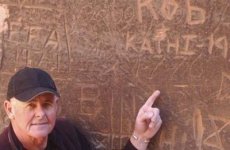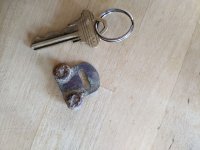kenb
Bronze Member
1776 Dominguez-Escalante party
Glen Canyon sandstone carving marks first European expedition in Utah
By Mark Havnes
The Salt Lake Tribune
Article Launched: 01/22/2008 03:45:56 AM MST
Jan 22:
Graffiti fighters show true GRITGLEN CANYON NATIONAL RECREATION AREA - The Dominguez-Escalante expedition left its mark on maps, in history books and, it appears, on a sandstone wall near Lake Powell.
The simple Spanish inscription "Pasa Por Aqui" - meaning "pass by here" - followed by the year "1776" can be found in soft stone near the Crossing of the Fathers on the Utah-Arizona state line.
Jim Page, leader of a grafitti-mitigation group that found the carving, said the style of the letters and scientific analyses, along with journals kept by the Catholic priest Silvestre Velez de Escalante, make it 98 percent certain that someone in the small band of early explorers chiseled the unsigned message.
If so, it represents the only physical evidence of the first European exploration of Utah.
"The diary pinpoints them being in the area Nov. 6 or 7," Page said. "They were impacted by a storm system on their way back to Santa Fe and were on the verge of starvation. My supposition is that one of them, not knowing if they were going to survive the journey or if Escalante's documents would perish with them, went into the alcove and left the carving."
The expedition, led by the priest Francisco Atanasio Dominguez, left the Spanish settlement in Santa Fe, N.M., on July 29, 1776, in search of a new overland route to a mission in Monterey, Calif.
After the group made
its way north through Colorado, it turned west into Utah, crossing the Green River near present-day Jensen in Uintah County. The small band of 10 ventured as far as today's Utah County before heading into southwestern Utah. Along the way its numbers grew to 11 or 12 members, including American Indian guides.
Near Lund, in Iron County, the snow began to fly and the members cast lots on whether to return to Santa Fe or continue hunting for a route to Monterey.
They decided to return to New Mexico, arriving back in Santa Fe on Jan. 2, 1777.
Page - who heads the Graffiti Removal and Intervention Team, which removes illegal carvings in the sandstone around Lake Powell - says two female GRIT volunteers found the inscription in September 2006.
Although showing severe wear after two centuries of sun, wind and rain, the "1776" mark's style captured their attention. Since then, the inscription has been authenticated through study of its cursive style and measurement of the amount of lead from the atmosphere deposited on the carving.
The inscription near Padre Bay is in a slot canyon that today stands as a virtual gallery of modern, illegal graffiti, including a scrawling scratched over the Dominguez-Escalante writing that reads "Rob and Kathi 1994" chiseled in the outline of a heart.
"It's a terrible thing," Page said. "I don't think people understand the damage they have done."
The graffiti over the inscription cannot be removed, but GRIT plans to rub out nearby carvings that include the names of rock bands, other lovebirds, even an image that looks like a beer can.
Despite all the illegal graffiti, the famous Dominguez-Escalante carving still can be detected. Kevin Schneider, a spokesman for the National Park Service, said 3 million people a year visit the park and until recently no one had recognized the significance of the inscription.
"It's a priceless piece of history," he said, "and should be protected."
To that end, Schneider said the inscription is in the process of being nominated for the National Register of Historic Places.
Even so, Schneider said that to protect the historical inscription from further vandalism, it is doubtful its precise location will be made public.
Craig Fuller, a historian with the Utah State Historical Society, said this marking is the only physical evidence remaining of the party's passing through the area.
Fuller said the steps carved into a cliff at the Crossing of the Fathers - described in Escalante's journal as allowing the party to reach the Colorado River - have been documented, but have since been covered by the lake.
He said the extensive testing of the recently discovered chiseled text leaves little doubt of its authenticity.
"It's been verified," he said. "It's not a hoax."
[email protected]
kenb
Glen Canyon sandstone carving marks first European expedition in Utah
By Mark Havnes
The Salt Lake Tribune
Article Launched: 01/22/2008 03:45:56 AM MST
Jan 22:
Graffiti fighters show true GRITGLEN CANYON NATIONAL RECREATION AREA - The Dominguez-Escalante expedition left its mark on maps, in history books and, it appears, on a sandstone wall near Lake Powell.
The simple Spanish inscription "Pasa Por Aqui" - meaning "pass by here" - followed by the year "1776" can be found in soft stone near the Crossing of the Fathers on the Utah-Arizona state line.
Jim Page, leader of a grafitti-mitigation group that found the carving, said the style of the letters and scientific analyses, along with journals kept by the Catholic priest Silvestre Velez de Escalante, make it 98 percent certain that someone in the small band of early explorers chiseled the unsigned message.
If so, it represents the only physical evidence of the first European exploration of Utah.
"The diary pinpoints them being in the area Nov. 6 or 7," Page said. "They were impacted by a storm system on their way back to Santa Fe and were on the verge of starvation. My supposition is that one of them, not knowing if they were going to survive the journey or if Escalante's documents would perish with them, went into the alcove and left the carving."
The expedition, led by the priest Francisco Atanasio Dominguez, left the Spanish settlement in Santa Fe, N.M., on July 29, 1776, in search of a new overland route to a mission in Monterey, Calif.
After the group made
its way north through Colorado, it turned west into Utah, crossing the Green River near present-day Jensen in Uintah County. The small band of 10 ventured as far as today's Utah County before heading into southwestern Utah. Along the way its numbers grew to 11 or 12 members, including American Indian guides.
Near Lund, in Iron County, the snow began to fly and the members cast lots on whether to return to Santa Fe or continue hunting for a route to Monterey.
They decided to return to New Mexico, arriving back in Santa Fe on Jan. 2, 1777.
Page - who heads the Graffiti Removal and Intervention Team, which removes illegal carvings in the sandstone around Lake Powell - says two female GRIT volunteers found the inscription in September 2006.
Although showing severe wear after two centuries of sun, wind and rain, the "1776" mark's style captured their attention. Since then, the inscription has been authenticated through study of its cursive style and measurement of the amount of lead from the atmosphere deposited on the carving.
The inscription near Padre Bay is in a slot canyon that today stands as a virtual gallery of modern, illegal graffiti, including a scrawling scratched over the Dominguez-Escalante writing that reads "Rob and Kathi 1994" chiseled in the outline of a heart.
"It's a terrible thing," Page said. "I don't think people understand the damage they have done."
The graffiti over the inscription cannot be removed, but GRIT plans to rub out nearby carvings that include the names of rock bands, other lovebirds, even an image that looks like a beer can.
Despite all the illegal graffiti, the famous Dominguez-Escalante carving still can be detected. Kevin Schneider, a spokesman for the National Park Service, said 3 million people a year visit the park and until recently no one had recognized the significance of the inscription.
"It's a priceless piece of history," he said, "and should be protected."
To that end, Schneider said the inscription is in the process of being nominated for the National Register of Historic Places.
Even so, Schneider said that to protect the historical inscription from further vandalism, it is doubtful its precise location will be made public.
Craig Fuller, a historian with the Utah State Historical Society, said this marking is the only physical evidence remaining of the party's passing through the area.
Fuller said the steps carved into a cliff at the Crossing of the Fathers - described in Escalante's journal as allowing the party to reach the Colorado River - have been documented, but have since been covered by the lake.
He said the extensive testing of the recently discovered chiseled text leaves little doubt of its authenticity.
"It's been verified," he said. "It's not a hoax."
[email protected]
kenb







